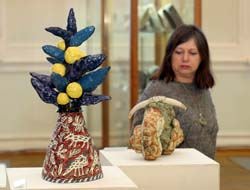Traditions of past millenniums in modern interpretations
The World of Clay Wonders features pottery from every corner of Ukraine
For the first time in the past decade professional ceramic artists and master folk craftsmen of Ukraine have gathered at the Museum of Ukrainian Folk Decorative Art for an exhibit that will last until April 11, 2008.
According to Viktor Samarsky, one of the organizers, the exhibit is launching a high-profile art project called Ceramics of Ukraine: Traditions of the Millennia. Part of it involves a national outdoor ceramics show that will be held in Donetsk oblast, in which the creators of the best works at the current exhibit will participate. Another scheduled event is the exhibit Ceramics of Ukraine: The Breath of Millennia, which will be held at Prague’s National Museum of History. But the most pleasant piece of news for ceramic artists is that Ukraine will hold a Biennale of Ceramics later this year.
The World of Clay Wonders exhibit features 200 ceramic works, such as pots, cups, saucers, and other samples of late 19th and early 20th-century pottery, as well as clay figurines, including slender female figures carrying baskets on their shoulders, awesome lions, and ceramic platters depicting Kyiv. But visitors are most impressed by Ukrainian folk masters’ works executed in a neo-avant-garde style. “Cornucopia,” by the young ceramic artist Mykhailo Zaitsevsky, is the embodiment of two worlds — spiritual and physical.
“I view the Horn of Plenty as a cosmic and slightly magical phenomenon, so I depicted it in the form of a crescent,” Zaitsevsky said. “These figures symbolize the reflection of material objects in space. In the past, ceramics were just articles of everyday use, but in the last decade it has become a type of high art and practically a kind of sculpture.”
Zaitsevsky is now working on modern decorative metal sculptures and installation art. He believes that contemporary art, including ceramics, helps artists raise major social and spiritual problems and reveal their vision of the world.
The current exhibit features traditional ceramic works that are no less riveting. At first glance, the pieces fashioned by the ceramist Serhii Kozak are done in yellowish-gray, a traditional color for ceramics, and appear to have been executed according to a classical pattern. At the same time, there is a spirit of the avant-garde in his creations. Kozak said that his work reflects his love for Van Gogh, as attested by his “one-eared pot.” He strives not to betray his personal style: he makes the main part of a piece on the potter’s wheel and then adds objects and details that give his work an unconventional look.
Classical Ukrainian ceramic art is also featured in the current exhibit. The Lviv-based ceramist Taras Levkiv has created over a thousand ceramics, including pieces executed according to a technique that is exclusive to Ukraine’s western regions.






